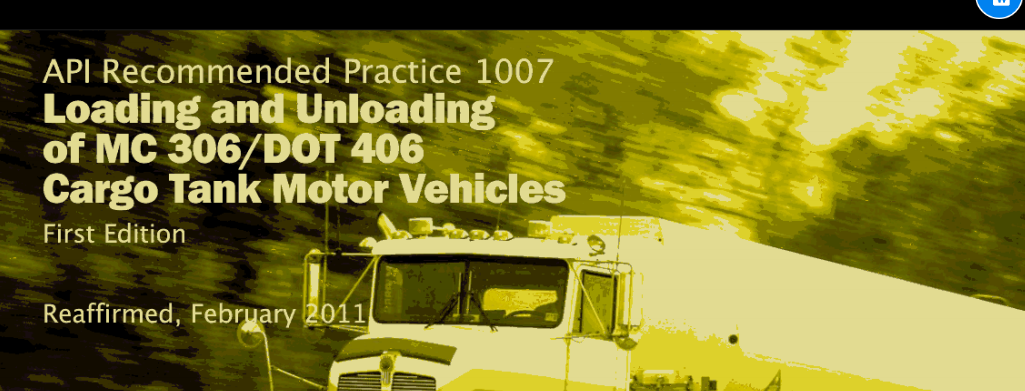API RP 1007:2001 pdf download.Loading and Unloading of MC 306/DOT 406 Cargo Tank Motor Vehicles.
4.1 Introduction
When maneuvering to enter and exit a customer location to deliver petroleum products, all clearances should be checked. Drivers should use extreme caution, paying particular attention to clearances to fixed objects, and remaining aware of the potential for other vehicles to move unexpectedly. Be particularly observant of the immediate area when hacking the tank truck. It may be advisable to get out of the truck and check the rear for obstacles or place traffic cones to mark a path, before hacking the truck. Maneuvering in close quarters, particularly hacking up. presents an increased risk of accidents.
1. Vapors are ignitable when mixed with air in the proper proportions and a source of ignition is present. Theretwe. all sources of vapors and ignition must be controlled or eliminated before or during unloading. There are several potential sources of vapors during unloading, including, but not limited to: vents, spills. leaks, hose rupture, customer spill at dispenser island or receiving tank overflow. Sources of ignition include, butare not limited to, smoking, open lights, heaters or fires,running engines, fans or electrical equipment. Ensure afire extinguisher is readily available at the unloadingarea and in good working order. If unsafe conditionssuch as leaks or concentration of vapors or sources ofignition occur during unloading, stop immediately anddo not resume unloading until these hazards are con-trolled or eliminated and spills are cleaned up.
2. Preventing product spills or overflows is one of adriver’s most important responsibilities when unload-ing. Even small spills or drips have the potential forsevere environmental consequences, as well as creatingan unsafe situation. It is recommended that a fullyequipped spill kit be readily accessible and used by thedriver to provide “first aid” containment in the event ofa small spill or leak.
3.US DOT regulations and state fire codes require thatdrivers remain within 25 feet (8 meters) and have anunobstructed view of the cargo tank. If for any reason the driver has to leave the immediate unloading area,the driver must shut down the entire operation, close allopenings to the tank and return all hoses to the properstorage areas.
4.2 Spotting the Vehicle
Drivers should pay special attention to people andboth parked and moving vehicles when moving the tanktruck at the customer’s location.
Drivers should also pay attention to avoid obstaclessuch as canopies, building overhangs, guard posts/rails,pumps, trash dumpster, etc.
1.The delivery tank truck should , if possible, be spottedon level grade and 25 feet (8 meters) upwind from anyvent that emits vapors.The tank truck should not beparked or left standing near a building or in a depressedor enclosed area that will trap vapors or collect liquids,which are ignitable.
2. The driver should apply the parking brake,placetransmission in lowest gear and place wheel chocks.
API RP 1007:2001 pdf download
